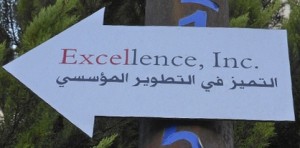
Last time I began a discussion of excellence in community engagement, saying “Advocates for community engagement in the arts often get pushback from people who assume that concern for the interests of our communities necessitates a ‘lowering of standards.'” This time I continue with a consideration of three potential categories of excellence that are often not part of our discussions in the arts.
Participatory Experiences
Rather than focus on all categories of excellence, I’d like to consider just three that are particularly important to community engagement. The first is the ability to craft participatory arts experiences for members of the community.
The arts of the European aristocratic cultural tradition have skewed toward passive observation rather than direct participation, especially in the last two generations with the decline of public school arts programs and private instruction in the arts. A strong case can be made that increasing opportunities for arts participation is vital to the future of the nonprofit arts industry. Regardless of that, presentation of spectator-oriented arts experiences is vastly different from creating effective participatory ones. It is not easy to do the latter. Excellence in participatory program design and implementation can (and I would argue should) be viewed as being as important as presenting performances and exhibitions. The fact that the resulting artistic product will likely not be technically proficient is irrelevant. It is the excellence of the experience for the participant and the resulting benefits to the arts that are key. It could even be argued that this is more important for the future of the arts, the well-being of society, and the viability of the arts organization than technical and expressive excellence. To drive the point home, the organization typically focused on traditional views of artistic excellence could be described as inferior in this category.
Community Benefit
The capacity to develop and maintain awareness of the interests and needs of the communities we serve is important for the health of arts organizations. To be effective, this must then be paired with the ability to create and present programming that serves the community. Many (if not most) arts organizations are skilled at presenting work that is excellent with respect to technique and expression. Unfortunately, too many are oblivious to community concerns or somewhat hamfisted in attempts to be of service. Improving skills in these areas can be an important step in ensuring a better future for the organization.
Personal Meaning
The impact of the art we present on the individuals who experience it is, or should be, the core concern of what we do. However, some in our industry are so focused on the art that they ignore this or unconsciously assume that the art will work its magic spontaneously. There is some question as to whether the latter was ever true for anyone who was not an arts aficionado. However, due to cultural issues addressed above and the pervasive lack of arts education and participation we have seen develop over the last fifty years, it is clearly not the case today. The ability of an arts organization to help people connect with the art they present is another category of excellence not directly related to technical/expressive proficiency, but it, too, is a skill critical to sustainability.
The ability to craft effective participatory experiences, to serve the interests of communities, and to make connections between people and the art we present are three categories (but only three of many categories) not directly related to technique and expressiveness. When speaking of excellence in our field we need to remember that there are a variety of things to consider, each of which are important. Technique and expressiveness are vitally important and for most organizations will continue to be the bedrock of their practice. However, the tendency to be almost exclusively focused on them is short-sighted and, in the long run, detrimental to the industry.
[Next time: Equity and respect.]
Engage!
Doug
Photo:![]()
![]() Some rights reserved by mikecogh
Some rights reserved by mikecogh

I’m saddened to see in your argument for community engagement the erasure of the term “artist”.
The individual artist is removed from the equation in favor of the community or the organization. Once the conversation switches to those two groups it’s hard to understand who you think is making the actual art under discussion; an artist following the dictates of an organizationally prescribed goal, or the community or organizational participants themselves.
In your first installment, I only see you refer to an individual artist once in terms of their expression and technical ability, which you dismiss when you say it is “nearly impossible to quantify but is also insufficient by itself.” and that “the technical flaws usually distract from and diminish the experience..”
After this, the individual artist is never mentioned again.
From the first paragraph of last week’s post, of which this is a continuation (and which you read because you commented on it):
“[This is] intended almost exclusively for arts organizations. Artists should be perfectly free to approach their art in whatever way seems best to them. However, if they are concerned about relevance or reaching more of the public, there may be things here of value.”
That would be fine except for the fact that most state and NEA grants to artists go through arts organizations, who in essence act as gate keepers as to who and what type of art moves forward in society. Great art that moves society and ultimately leads them is still created primarily by the individual artist’s vision not the artist having to follow an organizations requirements.